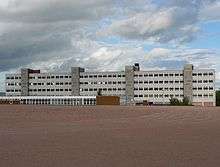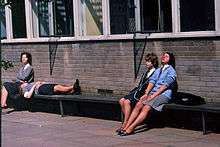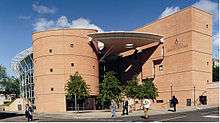Education in Scotland in the twentieth century

Education in Scotland in the twentieth century includes all forms of organised education in Scotland, such as elementary, secondary and higher education. The centre of the education system became more focused on Scotland throughout the century, with the Scottish Education Department partly moving north from 1918 and new departments created by the Scottish Executive after devolution.
The 1872 Education Act and the abolition of school fees in 1890 meant there was a state-funded, national system of compulsory free basic education with common examinations. The 1918 Education (Scotland) Act introduced the principle of universal free secondary education, brought the Roman Catholic schools into the state system, and replaced the School Boards with 38 specialist local education authorities. These would be subsumed into local government in 1929. Unlike the Education Act 1944 in England and Wales, which established the tripartite system, the Education (Scotland) Act 1945 was a consolidation measure. Secondary education was the major area of growth, particularly for girls. Selection was ended by the Labour government in 1965. New qualifications were developed to cope with changing aspirations and economics, with the Leaving Certificate being replaced by the Scottish Certificate of Education Ordinary Grade ('O-Grade') and Higher Grade ('Higher'). In the 1980s these were replaced by the Standard Grade qualifications and the curriculum was reformed to take account of the whole range of abilities.
In the first half of the twentieth century Scottish universities fell behind those in England and Europe in terms of participation and investment. After the Robbins Report of 1963 there was a rapid expansion in higher education in Scotland. By the end of the decade the number of Scottish Universities had doubled. New universities included the University of Dundee, Strathclyde, Heriot-Watt, Stirling. From the 1970s the government preferred to expand higher education in the non-university sector and by the late 1980s roughly half of students in higher education were in colleges. Under the Further and Higher Education Act 1992, the distinction between universities and colleges was removed, creating new universities at Abertay, Glasgow Caledonian, Napier, Paisley and Robert Gordon.
Organisation
The centre of the education system became more focused on Scotland throughout the century. The Scotch Education Department (SED) was officially named the Scottish Education Department and partly moved north in 1918. Its headquarters relocated to Edinburgh in 1939.[1] In 1991 it was renamed the Scottish Office Education Department, and then in 1995 it became the Scottish Office Education and Industry Department.[2] After devolution, in 1999 the new Scottish Executive set up a Scottish Education Department and an Enterprise, Transport and Lifelong Learning Department, which together took over its functions.[3]
Schools

The 1872 Education Act had established a system of elementary state education up until the age of 12, by taking over the schools of the Presbyterian churches and some charitable schools. The abolition of school fees in 1890 meant there was a state-funded, national system of compulsory, free, basic education with common examinations.[4] From this point attention increasingly turned to secondary education. The Scottish Education Department introduced vocational supplementary teaching in the elementary schools, later known as advanced divisions, up until the age of 14, when pupils would leave to find work. This was controversial because it seemed to be counter the cherished principle that schooling was a potential route to university for the bright "lad o' parts".[5] Larger urban school boards established about 200 "higher grade" (secondary) schools as a cheaper alternative to the burgh schools, most in relatively poor inner city areas.[4][5] There were also about 60 secondaries established by 1900.[5] The school leaving age was raised to 14 in 1901.[6]
The 1918 Education (Scotland) Act introduced the principle of universal free secondary education, although due to financial crisis and resistance from the SED it took almost two decades to implement. Most of the advanced divisions of the primary schools became junior secondaries, where students received a vocationally orientated education until the age of 14. The old academies and Higher Grade schools became senior secondaries, giving a more academic education, presenting students for the leaving certificate. Selection between the two types of school was determined at age 12 by an intelligence test, the "qualifying examination", known colloquially as "the qualy".[5] The 1918 Act brought the Roman Catholic schools into the state system, but retained their distinct religious character, access to schools by priests and the requirement that school staff be acceptable to the Church.[6] The Act also replaced the School Boards with 38 specialist local education authorities, which were elected by a form of proportional representation in order to protect the rights of the Catholic minority. These would be subsumed into local government in 1929.[5]

Unlike the Education Act 1944 in England and Wales, which established the tripartite system, the Education (Scotland) Act 1945 was largely a consolidation measure, because universal secondary education had already been in place for over a decade.[5] Plans to raise the school leaving age to 15 in the 1940s were never ratified, but increasing numbers stayed on beyond elementary education and it was eventually raised to 16 in 1973. As a result secondary education was the major area of growth, particularly for girls, who stayed on in full-time education in increasing numbers throughout the century.[6] The 1947 Report on Secondary Education by the Education Advisory Council, established by Labour minister Tom Johnston, proposed an end to selection and, although rejected by Labour and Conservative governments, became a benchmark for reform. Selection was ended by the Labour government in 1965, which recommended that councils produced one kind of comprehensive secondary school that took all the children in a given neighbourhood. By the late 1970s 75 per cent of children were in non-selective schools and by the early 1980s only the five per cent of children in private schools were subject to selection.[5]
New qualifications were developed to cope with changing aspirations and economics, with the Leaving Certificate being replaced by the Scottish Certificate of Education Ordinary Grade ('O-Grade') and Higher Grade ('Higher') qualifications in 1962, which became the basic entry qualification for university study.[1] In the 1980s these were replaced by the Standard Grade qualifications. The greater availability of academic qualifications encouraged students to stay on at school. In 1967 22 per cent of students stayed on beyond age 15, but by 1994 the number staying on beyond 16 was 74 per cent.[5] The reorganisation of local government in 1975, which transferred education to nine mainland and three smaller island authorities, allowed those containing large urban centres, to redistribute resources to poorer areas, making education part of a programme of wider social reform. In the 1980s the curriculum was reformed to take account of the whole range of abilities. In 1955 only 22 per cent of pupils achieved five or more passes in ordinary grade. By 1995 the proportion achieving the equivalent in the standard grade was 55 per cent. Gender differences disappeared as girls' attainment caught up with boys in the early 1980s.[5]
Universities

At the beginning of the century Scotland's four Ancient universities had 6,254 students.[7] From 1901 large numbers of students received bursaries from the Carnegie Trust.[7] By 1913 there were 7,776 students in Scottish universities. Of these 1,751 (23 per cent) were women. By the mid-1920s it had risen to a third. It then fell to 25–7 per cent in the 1930s as opportunities in school teaching, virtually the only careers outlet for female graduates in arts and sciences, decreased. No woman was appointed to a Scottish professorship until after 1945.[7] The fall in numbers was most acute among women students, but it was part of a general trend. In the first half of the twentieth century Scottish universities fell behind those in England and Europe in terms of participation and investment. The decline of traditional industries between the wars undermined recruitment to subjects in which Scotland had been traditionally strong, such as science and engineering. English universities increased the numbers of students registered between 1924 and 1927 by 19 per cent, but in Scotland the number of full-time students fell from 10,400 in 1924 to 9,900 in 1937. In the same period, while expenditure in English universities rose by 90 per cent, in Scotland the increase was less than a third of that figure.[8]
Before the First World War relationships between male and female students tended to be very formal, but in the inter-war years there was an increase in social activities, such as dance halls, cinemas, cafes and public houses. From the 1920s much drunken and high spirited activity was diverted into the annual charity gala or rag. Male centred activities included the Student's Union, Rugby Club and Officers' Training Corps. Women had their own unions and athletics clubs. Universities remained largely non-residential, although a few women's halls of residence were created, most not owned by the universities.[7]

After the Robbins Report of 1963 there was a rapid expansion of higher education in Scotland. By the end of the decade the number of Scottish Universities had doubled. The University of Dundee was demerged from St. Andrews to become a separate institution, Strathclyde and Heriot-Watt were developed from technical colleges and the Stirling was begun as a completely new university on a greenfield site in 1966. From the 1970s the government preferred to expand higher education in the non-university sector of educational and technical colleges, which were cheaper because they undertook little research. By the late 1980s roughly half of students in higher education were in colleges. In 1992, under the Further and Higher Education Act 1992, the distinction between universities and colleges was removed.[9] This created new universities at Abertay, Glasgow Caledonian, Napier, Paisley and Robert Gordon.[10] Despite the expansion the number of male students experienced a downturn in growth from 1971 to 1990. The growth in female student numbers was much larger and continued until by 1999 and 2000 the numbers of women students exceeded male students for the first time.[11] After devolution, one of the major diversions from practice in England was the abolition of student tuition fees in 1999, instead Scotland retained a system of means-tested student grants.[12]
Notes
- 1 2 R. Anderson, "The history of Scottish Education pre-1980", in T. G. K. Bryce and W. M. Humes, eds, Scottish Education: Post-Devolution (Edinburgh: Edinburgh University Press, 2nd edn., 2003), ISBN 0-7486-1625-X, pp. 219–28.
- ↑ John P. Wilson, The Routledge Encyclopaedia of UK Education, Training and Employment: From the Earliest Statutes to the Present Day (London: Routledge, 2013), ISBN 1317796527, p. 272.
- ↑ J. Fairley, "The Enterprise and Lifelong Learning Department and the Scottish Parliament", in T. G. K. Bryce and W. M. Humes, eds, Scottish Education: Post-Devolution (Edinburgh: Edinburgh University Press, 2nd edn., 2003), ISBN 0-7486-1625-X, pp. 132–40.
- 1 2 R. Anderson, "The history of Scottish education pre-1980", in T. G. K. Bryce and W. M. Humes, eds, Scottish Education: Post-Devolution (Edinburgh: Edinburgh University Press, 2nd edn., 2003), ISBN 0-7486-1625-X, pp. 219–28.
- 1 2 3 4 5 6 7 8 9 L. Patterson, "Schools and schooling: 3. Mass education 1872–present", in M. Lynch, ed., The Oxford Companion to Scottish History (Oxford: Oxford University Press, 2001), ISBN 0-19-211696-7, pp. 566–9.
- 1 2 3 C. Harvie, No Gods and Precious Few Heroes: Twentieth-Century Scotland (Edinburgh: Edinburgh University Press, 3rd edn., 1998), ISBN 0-7486-0999-7, p. 78.
- 1 2 3 4 R. Anderson, "The history of Scottish Education pre-1980", in T. G. K. Bryce and W. M. Humes, eds, Scottish Education: Post-Devolution (Edinburgh: Edinburgh University Press, 2nd edn., 2003), ISBN 0-7486-1625-X, pp. 612–14.
- ↑ C. Harvie, No Gods and Precious Few Heroes: Twentieth-Century Scotland (Edinburgh: Edinburgh University Press, 3rd edn., 1998), ISBN 0-7486-0999-7, pp. 78–9.
- ↑ L. Paterson, "Universities: 3. post-Robbins", in M. Lynch, ed., The Oxford Companion to Scottish History (Oxford: Oxford University Press, 2001), ISBN 0-19-211696-7, pp. 614–5.
- ↑ R. Shaw, "Institutional and curricular structures in the universities of Scotland" in T. G. K. Bryce and W. M. Humes, eds, Scottish Education: Post-Devolution (Edinburgh: Edinburgh University Press, 2nd edn., 2003), ISBN 0-7486-1625-X, pp. 664–5.
- ↑ C. G. Brown, "Chapter 1- Charting Everyday Experience", in L. Abrams and C. G. Brown, eds, A History of Everyday Life in Twentieth-Century Scotland (Edinburgh: Edinburgh University Press, 2010), ISBN 0748624317, p. 28.
- ↑ D. Cauldwell, "Scottish Higher Education: Character and Provision", in T. G. K. Bryce and W. M. Humes, eds, Scottish Education: Post-Devolution (Edinburgh: Edinburgh University Press, 2nd edn., 2003), ISBN 0-7486-1625-X, pp. 62–73.
| ||||||||||||||||||||||||||
| ||||||||||||||
